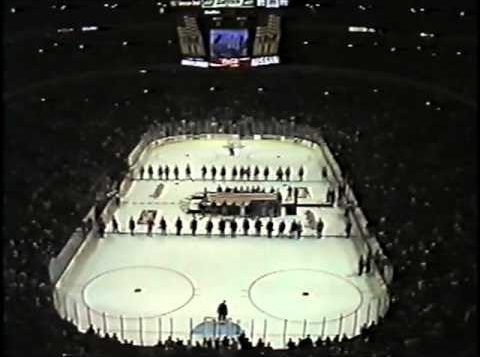This Day in Hockey History – January 25, 1995 – No Place Like Home for Blackhawks
In Chicago, the United Center cost $175 million and took up about one million square feet. The old Chicago Stadium had been built for $7 million back in 1929 and was only 600,000 square feet. According to a special feature in the Chicago Tribune, the United Center did not have the same grandeur or design as Chicago Stadium, but the roof had 28 times the amount of steel in the Statue of Liberty. It also featured much better sightlines (instead of about 1,500 seats with pillars obstructing views).
The first event at the newly constructed United Center was the World Wrestling Federation’s SummerSlam ’94 in August. Over the next two months, the arena was intended to become the home of the Chicago Blackhawks then the Chicago Bulls. It was already slated to host the 1996 Democratic National Convention.
On September 16, 1994, the Blackhawks did play a preseason exhibition game, which they lost 2-1 to the St. Louis Blues. Only 16,429 fans came out, but they were still loud. The Hawks had their first taste of the regulation-sized ice surface. Their old surface was only 185 feet long compared to regulation at 200. Coach Darryl Sutter assured the press, “It really won’t affect our style of play at all.” The team favored the strategy to “dump the puck into the offensive zone and chase it,” but the longer rink would “open more ice” for skilled offensive players.
However, by the time September was ending, it seemed inevitable that there would be a lockout. Although the Bulls were able to move into the United Center (and even retired Michael Jordan’s No. 23 at the beginning of November), the Blackhawks had to wait four months to even officially begin the 1994-95 season. Then, their first two games (of 48) were on-the-road losses.
Finally, on January 25, 1995, the Blackhawks played their first regular season hockey game at the somewhat new United Center. Brent Grieve, new to the Blackhawks that season, said, “All through the lockout I couldn’t wait to play the first game in the United Center. I hope it will be memorable.” Star Jeremy Roenick seemed assured. “When they start screaming and see what it’s like, I guarantee it will be louder. I think they’re a little tentative to try it out. They’re a little in awe of the building and thinking of the old building.” Sure enough, an over capacity crowd of 20,536 “rocked” the new rink during Wayne Messmer’s final performance of the national anthem for the Blackhawks. “It’s home. It’s our rink,” began Chris Chelios. “If we play well and work hard the fans will have the same effect as in the old building.”
The Blackhawks did not let their fans down. Joe Murphy scored the first goal at 11:33 of the second period. After two more goals in that period and another in the third, Bernie Nicholls scored his first Blackhawks goal on an Oilers’ power play. He commented, “It was a very special night. The crowd was great; they were an extra player for us.” After that, the Oilers pulled goalie Bill Ranford at 1:30 in the third period. Meanwhile, Chicago goalie Ed Belfour only faced six shots during the first two thirds of the game. He lost his shutout opportunity with only 3:46 remaining. The Blackhawks won 5-1. Defenseman Steve Smith summarized, “The United Center has some nice attributes and I’m excited about playing in there. It’s important for us to look at it as our home.”
The United Center had some down sides. It took much longer to switch from the basketball floor to ice. As the director of operations, Jim Koehler, explained, “There’s more mechanics like the retractable seats in the end zones.” That meant that the Blackhawks did not have as much time to practice on their own rink but usually had to use the UIC rink instead. On the other hand, its greater seating capacity meant that the Blackhawks set the NHL record when it averaged 20,833 fans over that season. No other team had topped 20,000 on average. At the end of the season, Chicago made it to the conference finals.
Additional Sources:
- Howell J. Malham Jr., “Pro wrestling crowd christens new United Center,” Chicago Tribune, 30 Aug. 1994, section 5, p. 1.
- “A Fan’s Guide: The United Center,” section 7, of Chicago Tribune, 7 Sept. 1994.
- “No. 23 Flies to the Rafters” and “Tribute Fails to Reach Proper Heights,” Chicago Tribune, 2 Nov. 1994, section 4, p. 1 and 5.
- Robert Markus, “New home a lot noisier than Hawks,” Chicago Tribune, 17 Sept. 1994, section 3, p. 1-2.
- Robert Markus, “At long last, Hawks take Center stage,” Chicago Tribune, 25 Jan. 1995, section 4, p. 3.
- Robert Markus, “Hawks enjoy move into new home with big victory party” and “Practice time on United Center ice melts away,” Chicago Tribune, 26 Jan. 1995, section 4, p. 5.
- Michael Hirsley, “Hawks’ home opener has it all: Light show, Messmer and victory,” Chicago Tribune, 26 Jan. 1995, section 4, p. 1 and 5.














